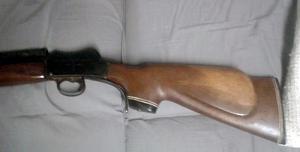That is actually a very nice-looking piece of wood, which I would be reluctant to part with. tsHardness doesn't necessarily come with resistance to splitting, but it usually does, and that wood might prevent the bugbear of Martinis, wood splitting away at the top of the butt socket. If you do want to restock, though, the Martinis, large or small, are among the easiest to do yourself. The main thing is to make sure that the butt, through wood or epoxy, exerts pressure on the inside front of the socket, not just the edges. This picture is my stock-drilling... er... thing. It follows the usual rule with holes, which is that you should make your hole first, and then the outside around it.
Attachment 150956
I know a lot Australian woods were evaluated as potential substitutes for Lee-Enfield stocks, and mostly found to some degree unsatisfactory. But that was before tungsten carbide woodworking cutters, and lots of forms of unsatisfactory don't apply once you have got your stock, and someone else had to do the suffering for it. I believe there are, or used to be, carbide checkering tools, but I remember shuddering at the price, as they were only economical for series production. I'd leave it the way it is, but if you feel you need something you could do stippled panels like we sometimes see on target rifles, or inlay panels of more easily checkerable wood.
I'm currently dabbling in ramshorn handled walking-sticks, principally because a win certificate from the local cattle show may be the only way to get my 88-year-old mother in law to use one. I was surprised by just how much faster than rasps and yet controllable tungsten carbide burrs could be, and your wood wouldn't harm them.
Yes, it's a pity about the old boot, and the white spacers, but it isn't disastrous. Before restocking I would spend a bit of time with pencil and paper, and see if I couldn't remodel that pistol grip. There is no good reason why a pistol grip cap in a contrasting wood or horn shouldn't be a bit thicker at the front than the rear. I've done that in bronze when I wanted to build weight into a .300H&H which would still look like a sporting rifle. It is unlikely that they rehardened the lever after bending it (they didn't need to), so it could be bent into slightly less of a curve, to get back to where the pistol grip cap comes a fraction lower down.
I once used a half inch ball-shaped tungsten carbide burr to shape the end of the lever, and brazed on a half-inch soft steel ball (sold on eBay for, I believe, use in catapults.) A ball bearing would surely work as well, but I would use acid to remove the polish first. Or you could use a little steel ring, which was sometimes used to attach a looped thong for operation by freezing hands, although I suppose that is a rare requirement in Australia.















 Reply With Quote
Reply With Quote







